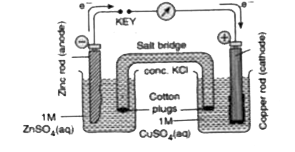What is galvanic cell ? Discuss briefly with one example.
The device in which electrical energy is produced from chemical reactions is called galvanic cell. The common galvanic cell is a Daniel cell. It consists of two beakers containing 10 M solution of ZnSO4, and 1.0M solution of CuSO4. A zinc rod is dipped into ZnSO4 solution and a copper rod is dipped into CuSO4 solution. These rods act as electrodes. The solution in the two beakers are connected by inverted U tube containing concentrated solution of some electrolyte such as KCI,KNO3 or NH4NO3. The two openings of the U tube are plugged with some porous material such as glass wool or cotton.

The U tube which connects the two glass beakers is called salt bridge.
Salt bridge completes the cell circuit and increases the life of the cell. The arrangement is shown in Fig. When the two electrodes are connected through a voltmeter, the flow of electric current through external circuit is indicated by the voltmeter. The cell formed is called galvanic or voltaic cell.
The potential difference is due to the contribution of two half cells. At zinc electrode, zinc is oxidised to Zn2+ ions which go into the solution. The electrons released at zinc electrode move towards the other electrode (copper) through the outer circuit. These are accepted by Cu2+ ions of CuSO4 solution which are reduced to copper. Thus, oxidation occurs at zinc electrode and it is called anode. Reduction occurs at copper electrode and it is called cathode. The reactions may be represented as :
At anode :
Zn(s)→Zn2+(aq)+2e (oxidation)
At cathode :
Cu2+(aq)+2e→Cu(s) (reduction)
The overall cell reaction is
Zn(s)+Cu2+(aq)→Zn2+(aq)+Cu(s)
The reactions occurring at anode and cathode are also referred as oxidation half cell reaction and reduction half cell reaction. The cell may be represented as :
Zn(s)∣∣Zn2+(aq)∣∣∣∣Cu2+(aq)∣∣Cu(s)
Anode (-) Cathode (+)
Topper's Solved these Questions
- ELECTROCHEMISTRYBOOK - MBD -HARYANA BOARDCHAPTER - ELECTROCHEMISTRYEXERCISE - SHORT ANSWER TYPE QUESTIONS
37 Videos
- CHEMISTRY IN EVERYDAY LIFEBOOK - MBD -HARYANA BOARDCHAPTER - CHEMISTRY IN EVERYDAY LIFEEXERCISE - Long answer type questions
5 Videos
- GENERAL PRINCIPLES AND PROCESSES OF ISOLATION OF ELEMENTS BOOK - MBD -HARYANA BOARDCHAPTER - GENERAL PRINCIPLES AND PROCESSES OF ISOLATION OF ELEMENTS EXERCISE - LONG ANSWER TYPE QUESTIONS
3 Videos
Similar Questions
Discuss briefly the concept of an amplifier.
View SolutionDiscuss briefly
Light reaction
View SolutionWhat are fuel cells ? Discuss briefly hydrogen-oxygen fuel cell ?
View SolutionWhat is inertia ? Discuss its types giving one example in each case.
View SolutionDiscuss briefly the structure of CsCl.
View SolutionWhat is mobile telephony? Discuss briefly its usage. Mention some points of concern in the usage of cell phones.
View SolutionWhat is chemotherapy ? Describe the following briefly with one example in each case: antipyretics.
View SolutionWhat is chemotherapy ? Describe the following briefly with one example in each case: analgesics.
View SolutionWhat are enzymes? Discuss briefly the classification of enzymes according to I.U.B. system giving classical examples of each class.
View SolutionWhat are proteins ? Discuss briefly the structure of proteins .
View Solution
